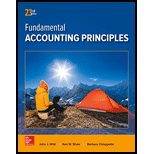
Introduction:
FIFO method: FIFO Stands for First In First Out. Under this method, the units purchased first are assumed to be sold first and cost of goods sold is calculated accordingly. The ending inventory in the method includes the latest units purchased.
LIFO method: LIFO Stands for Last In First Out. Under this method, the latest units purchased are assumed to be sold first and cost of goods sold is calculated accordingly. The ending inventory in the method includes the oldest units purchased.
Requirement-1:
To determine: The effect of the change in inventory method from LIFO to FIFO on profit margin and
Requirement-2:
To determine: If the action to change the
Want to see the full answer?
Check out a sample textbook solution
Chapter 6 Solutions
Fundamental Accounting Principles
- If beginning and ending work in process inventories are $12,500 and $21,700, respectively, and cost of goods manufactured is $215,000, what is the total manufacturing cost for the period? HELParrow_forwardI need help with this solution and general accounting questionarrow_forwardCompute the gross profitarrow_forward
- Can you solve this general accounting problem with appropriate steps and explanations?arrow_forwardWhich of the following is an example of a non-operating income item? a) Sales revenueb) Interest incomec) Wages expensed) Cost of goods soldarrow_forwardDuring October, Department X started and completed 92,000 units and also finished 28,000 units that were 60% completed on September 30. On October 31, Department X's ending inventory consisted of 25,000 units that were 40% completed. All manufacturing costs are incurred at a uniform rate throughout Department X's production process. Compute the number of equivalent full units of production for Department X during October. (FIFO Method)arrow_forward
- If beginning and ending work in process inventories are $12,500 and $21,700, respectively, and cost of goods manufactured is $215,000, what is the total manufacturing cost for the period?arrow_forwardCorrect Answerarrow_forwardI need guidance with this general accounting problem using the right accounting principles.arrow_forward
- Hello tutor solve this question and accounting questionarrow_forwardWhat is goodwill in accounting? a) The value of a company’s brand and reputationb) The excess of the fair value of assets acquired over their book valuec) The amount a company earns from its operationsd) The cost of capital used in financing a businessarrow_forwardI am trying to find the accurate solution to this general accounting problem with appropriate explanations.arrow_forward

 AccountingAccountingISBN:9781337272094Author:WARREN, Carl S., Reeve, James M., Duchac, Jonathan E.Publisher:Cengage Learning,
AccountingAccountingISBN:9781337272094Author:WARREN, Carl S., Reeve, James M., Duchac, Jonathan E.Publisher:Cengage Learning, Accounting Information SystemsAccountingISBN:9781337619202Author:Hall, James A.Publisher:Cengage Learning,
Accounting Information SystemsAccountingISBN:9781337619202Author:Hall, James A.Publisher:Cengage Learning, Horngren's Cost Accounting: A Managerial Emphasis...AccountingISBN:9780134475585Author:Srikant M. Datar, Madhav V. RajanPublisher:PEARSON
Horngren's Cost Accounting: A Managerial Emphasis...AccountingISBN:9780134475585Author:Srikant M. Datar, Madhav V. RajanPublisher:PEARSON Intermediate AccountingAccountingISBN:9781259722660Author:J. David Spiceland, Mark W. Nelson, Wayne M ThomasPublisher:McGraw-Hill Education
Intermediate AccountingAccountingISBN:9781259722660Author:J. David Spiceland, Mark W. Nelson, Wayne M ThomasPublisher:McGraw-Hill Education Financial and Managerial AccountingAccountingISBN:9781259726705Author:John J Wild, Ken W. Shaw, Barbara Chiappetta Fundamental Accounting PrinciplesPublisher:McGraw-Hill Education
Financial and Managerial AccountingAccountingISBN:9781259726705Author:John J Wild, Ken W. Shaw, Barbara Chiappetta Fundamental Accounting PrinciplesPublisher:McGraw-Hill Education





